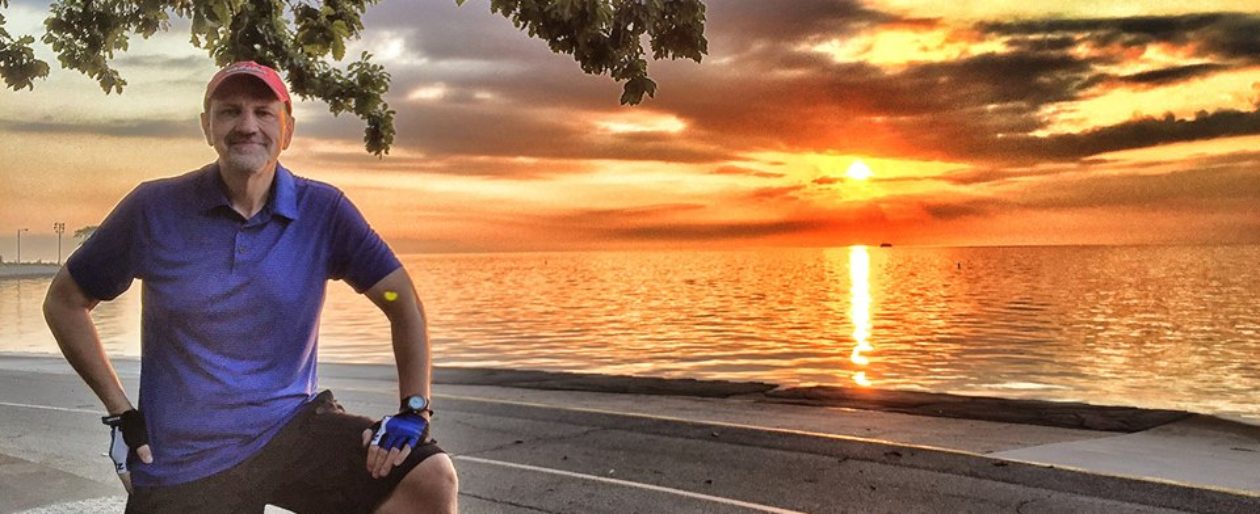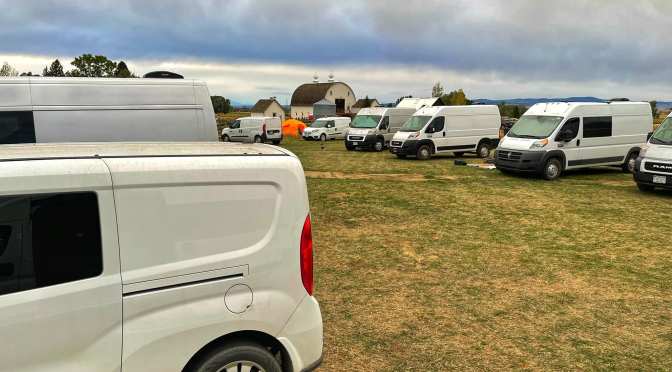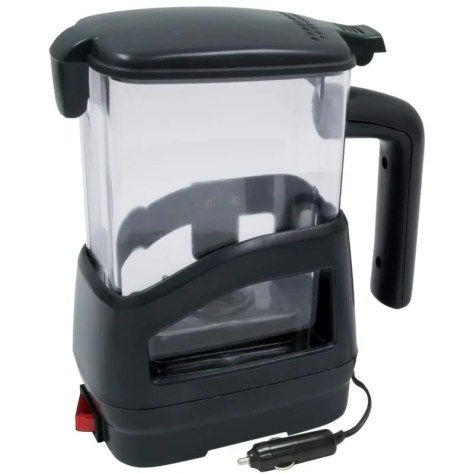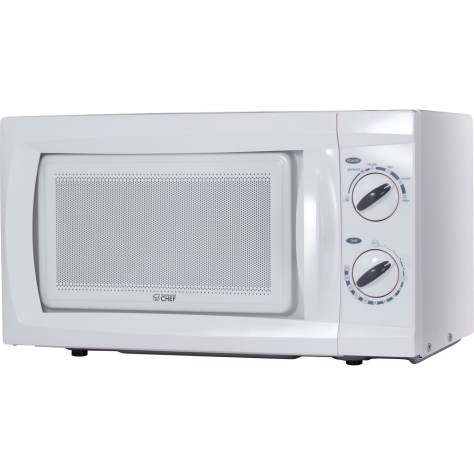Retirement brings both familiarity and surprises. Routines and novel experiences. It is no more static than working life, it is just different. And so I decided to go to a van dweller meet up, and here I sit outside of Bozeman, Montana in a barn, typing this post.
I decided to come here because I wanted to have the experience of meeting other van dwellers. I wanted to talk to them, and I wanted to see their van creations. I also wanted to challenge myself.
All of us at the meet-up had a basic buildout from Wayfarer Vans in Colorado Springs. My Violet was born there in 2018, while most of the other vans at the get-together had a newer lineage and thereby fancier additions. However, Violet was more than PVC walls and hand sewed colored cushions. Every year my friend Tom and I would tweak her, add to her abilities, and increase her functionality. Violet may not be the newest Wayfarer van, but I absolutely believe that she was the most beautiful of them all.
Today’s post goes beyond paint colors and cushion choices. Going to the meetup at the Star M ranch in Bozeman, Montana presented to me new challenges and surprising introspections that started well before I packed my travel snacks and filled my gas tank.
Despite my strong desire to attend I also had a sense of dread. I had asked Julie to accompany me but, understandably, she wasn’t interested in a 1400 mile trip to a dusty field. To go alone would mean that I would have to face any and all challenges of the journey by myself. To go alone would mean that I would have to put on my functional extrovert face, a performance that I am skilled in donning, but still an energy-draining experience.
As a professional interviewer, I have no problem engaging others when I am invited to do so. However, I have never quite gotten over my childhood expectation of being seen and not heard. It is immensely difficult for me to walk up to a stranger and start a conversation. My upbringing taught me that my thoughts and opinions were of interest to no one.
Intellectually, I have long known that this is not the case. Most people are happy, even eager to engage in casual conversation. However, old tapes run deep. Many years ago I decided to challenge those beliefs, and I did so in my usual manner of study, brute force, and repetition. My teacher was my friend, Tom.
Tom and I are very similar in our interests and temperament. However, we come to the table with different skill sets, and so we tend to utilize each other to compensate for those areas where we need shoring up. Our friendship has a practical side in that we constantly help each other to be “better.”
Tom has superior social skills and has an effortless ability to engage with strangers. I have witnessed him on dozens of occasions extracting personal information from a person that he has just met. “So how much money does a cement truck driver make?” Would be typical of a question that he would have no difficulty asking, and one apparently that most people have no problem answering.
I have the knowledge of how to engage with people, but watching Tom taught me that it was OK to engage with them. This may sound like a trivial distinction, but it is not. I have successfully adopted his techniques many times over the years, but I have never done so in an environment where I would be interacting with dozens of strangers, alone and without the benefit of an event that I was in charge of. The thought of doing so added to my anxiety, but it was insufficient to stop me. I have not gotten as far as I have in life by yielding to my anxieties. Fear is a barrier that I will climb over or burst through if necessary. I lived an early life being told that I was worthless. I was not about to live an adult life when I subconsciously told myself the same thing. I have value. I can contribute. I will only be limited by my true limitations and not by remnant ghosts from the distant past.
I usually deal with my anxiety by planning and problem solving, which is what I did for this trip. I wrote out a grocery list and made sure that my 12 volt Dometic fridge was sanitized and clean. I charged my USB flashlight and Bluetooth speaker. I checked the local weather and explored several plotted courses on Google Maps. I still had some residual anxiety, but that was to be expected.
What I didn’t expect was what happened to me several days before I started my trip. On Saturday I cleaned out and washed Violet, and I reorganized her storage. I also gathered nonperishables from our pantry. On Sunday I was supposed to go to a cousin reunion, but I had tickets for a Paramount production of “Kinky Boots.” I had purchased the tickets before the pandemic, but the play was on hold once shelter-in-place was instituted. This would be the first time that I would attend a public performance in almost 18 months. Sadly, this would mean that I would miss the reunion.
The play was a bit of fluff with a dash of “message.” The premise was ridiculous, a business is saved from bankruptcy by a drag queen who helps a straight-laced shoe factory owner make kinky boots designed to support drag queen feet. However, another message was folded into the fluff. Two men, very different, each dealing with the demons from their past help each other. I left the play feeling that my time was well spent, but I also acknowledged that the overall experience would be quickly forgotten.
On Monday I was to help my friend Tom. He was remodeling a bathroom for a Naperville client. He wanted me to take some before photos of the space as it would soon be demolished. These photos would serve as a counterpoint to photos that I would take of the finished job. The latter laboriously photographed and carefully edited to make the bathroom appear beautiful enough for a spread in “House Beautiful.”
I take these jobs very seriously and I approach them as such. On Sunday night I pulled out my professional gear, a Canon 5D Mark IV, and charged its battery. I selected and mounted a wide-angle lens on the camera body, and I made sure that my flash was in working order. As I said above, Tom helps me, and I help Tom.
On Monday I felt off. I drove to Tom’s place and got into his Flex. We arrived at the remodel site and were greeted by the client. Tom looked over his shoulder at me and told her, “This is Mike he is an amateur photographer and he will be taking some photos for me of the bathroom. That simple statement caused me to snap out loud, “I’m a professional photographer.” It also caused something to snap inside of me. It is clear that the client and her husband picked up on my comment as they continued the line of conversation in a joking way, but with a slight air of classism. With a chuckle, the husband asked me where my gallery was, and if I was planning on submitting my photos to “Home and Garden.” It was not the right thing to say to me at that moment. I bit my lip, weakly smiled, and offered a comment designed to end his line of questioning. He quieted and left the room. There was no way that I was going to jeopardize my friend Tom’s job. However, I was now boiling inside.
Dear readers, I am almost always a very calm and deliberate person. It is extremely unusual for me to raise my voice, and even more unusual for me to do so without a thoughtful and logical delivery. However, as soon as his clients were out of earshot I let loose on poor Tom. My rage was palpable as I told him in no uncertain terms that telling a client that I was an amateur inhibited me from doing my job to the best of my ability. I reminded him that I was doing professional work for him, despite the fact that I was doing it for free. I highlighted to him the time spent before and after a shoot, and the effort involved during those periods. Tom’s tendency is to interrupt and explain, but I was having none of this. With my finger pointed at him, I told him in no uncertain terms that I didn’t give a shit about his excuses. It was as if I was possessed by an outside entity. My rage dumped on him, but there was no sense of relief, rather I was consumed by a sense of confusion. What just happened, and why did it happen? I had no answer.
I helped Tom with a few menial tasks, but I did so quietly. I made small conversation, but it was stilted and awkward. Finally, he drove me back home, but he didn’t take me there, and instead he took me to his Devonshire property. “Aren’t you going to take me home,” I asked? “Mike, you drove your car here,” he replied. I was so upset that I completely had forgotten that I had done so. I got into Violet and drove the 5 minutes back to my house and promptly went upstairs and laid down on my bed as I tried to process what had just happened. One of the reasons was apparent. Like many men, I value respect above other values. In my mind, Tom was disrespectful of me by calling me an amateur when I have done many professional-level jobs for him. His actions were further amplified by the clients’ comments that seemed to imply that my attestation that I was a professional photographer was subject to ridicule. Still, my out-of-control retort to Tom seemed well beyond a simple case of a bruised ego.
After a bit, I forced myself out of my bed and went downstairs. I was still feeling surly and felt obligated to warn both Julie and Kathryn that I was very crabby, but not angry at them. However, I emphasized that my anger was generalized and that they should stay clear of me. As the day progressed I continued to feel a general dissatisfaction towards everyone, especially myself. I was completely baffled why I was being so reactive. Yes, I had some anxiety about driving to Bozeman, but that hardly could be the nidus for my volcanic rage. I just don’t feel that level of anger.
As the day went on I started to feel progressively more guilty about the morning’s events. I shot Tom a few friendly text messages. In turn, he did the same and mentioned that he wanted to formally secure Violet’s Wabasto heater. Tom had helped me install the heater a few months earlier and mentioned doing this final step at that time. However, this was not necessary for the trip. My sour mood continued.
I’m usually good at identifying behavioral triggers, but I was coming up dry. As the evening progressed I called my sister, Nancy, and voiced my concerns. Nancy is a professional therapist and offered me both support and insight. Unfortunately, I had already examined and discounted the behavioral causes and effects that she suggested. Yet, I was ever grateful for her support and kind ear.
Julie was in the room folding laundry as I pondered my anger with Nancy. Julie asked, “Would you like to hear my thoughts?” “Of course,” I replied. Her first thought was that she had recently gained some accolades and she wondered if I was feeling upstaged by her. I replied, “No, I’m happy when you succeed. I like basking in the glow of your successes.” She paused for a moment, almost to second guess what she was about to say. “Maybe it was the play?” I responded, “The play, why would that silly play have such an impact on me?” “Well, it involved men who were a disappointment to their fathers who didn’t believe in them. Fathers who wanted their sons to conform to their wishes while ignoring their dreams and aspirations. Sort of like your childhood.” Click…

I instantly felt a release as the anger that I was feeling washed away from me. I hadn’t been able to figure out my reaction because it was too primitive, too dangerous, too risky to bring into my conscious self. Julie could see my internal conflict and her Ph.D. training gave her the ability to articulate it in a clear and therapeutic way for me. I was very grateful. Later that day I talked to my sister, Carol. Just like my sister Nancy, she was completely supportive of me and completely accepting. Like Nancy, she had no reservation to tell me that I was special, good, and loved.
I now realized that on the morning of the incident Tom represented my father and thereby served as a lightning rod for the anger that I was feeling on a subconscious level. In my primitive mind, he was rejecting me and my talents. I felt like he was saying that I was not good enough. This feeling was exacerbated by Tom’s client’s comments that humorously mocked the idea that I could consider myself a professional.
When I turned 18 I decided to take control of my life and I used the rage that I felt as a tool to propel me forward. I was going to allow myself to be who I was, do what I thought was in my best interest, and not allow anyone to be disrespectful of me or my abilities. No one had to agree with me, but no one was allowed to make fun of me. Doing so would result in the full force of my abilities to put them back in their place. Thankfully, I almost never had to do the above as most people were both respectful and considerate towards me, and this only increased as I amassed ever more degrees and titles. However, the play opened up a wound that I thought was long healed, and anger that I felt I had conquered decades earlier.
The next day I met with Tom, who was quiet and a bit standoffish. He had driven to a different suburb to buy a specialty tool to affix the Wabasto heater for me and refused when I offered to pay for the part. After he secured the unit I asked him if he had a minute because I needed to talk to him. To the best of my ability, I made sincere amends to him for my actions from the previous morning. My tough-guy sailor mouth friend was genuinely hurt by my prior eruption, and he let me know that. I felt relieved to say that I was sorry but genuinely upset that I hurt his feelings. I hoped that my bad actions had not irreparably damaged our friendship. However, that was all that I could do.
Despite the relief of understanding my outburst, I still had the stress of the upcoming trip. Tom signaled that we were good by offering to meet up for coffee on the morning of my departure. Julie did an extra load of laundry for me so I would have enough shorts and shirts for my adventure. Kathryn checked in with me several times to ask if I was feeling better, and both of my sisters continued to offer their unending support and love.
There is something powerful about real love, and each of these individuals showed me this before my journey. I am ever grateful. They were there for me despite my crankiness. I knew that I could get people to connect with me if I was brilliant, funny, interesting, or thoughtful. Here were 5 people who loved me at a time when I was none of the above. I was good enough just being me. How many people don’t have a single person who truly loves them? Here, I had five. I felt blessed beyond belief.
I still had to deal with my internal anxiety, but at least I was in a position to do so without the burden of past demons. At 9:30 AM I boarded Violet to start my journey. She was packed with clothes and groceries. Next to me was my snack bag, hydro flask, coffee thermos, and Motrin. I was as ready as I could be and feeling significantly calmer about the task ahead.

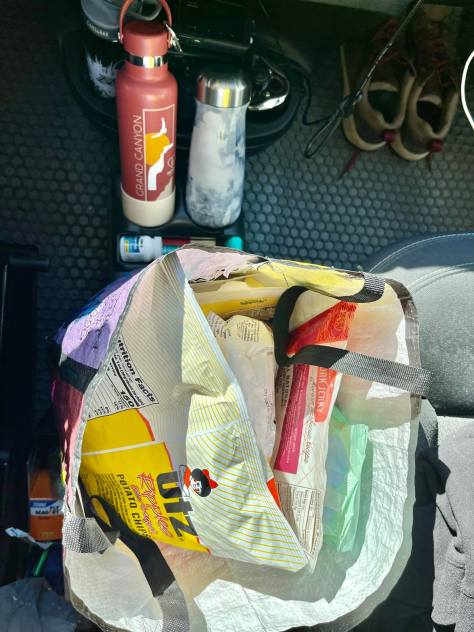
I pulled out of my driveway while listening to mechanical directions from Google Maps. Off I went.
The initial part of my journey was familiar and comforting as I drove past Rockford and into Wisconsin. I had taken that path many times driving to Julie’s Minnesota family. Beyond Minneapolis I would be heading to Fargo, North Dakota, then Bozeman, Montana.
Despite road construction driving conditions were good. I entertained myself by scanning local radio stations, listening to Sirius radio feeds, and talking on the phone. The trip was long, but I was feeling calm. I decided to drive until I felt tired as opposed to driving a certain distance. That feeling happened in Northern Minnesota. I found myself forcing my eyes open and I knew that it was time to call it a day. I searched for a campground but found none. I found respite in a Minnesota rest area. I pulled into a far corner of the parking lot, covered my windows with my homemade Reflectix shades, and crawled into bed.

The next morning I made a quick breakfast using my induction cooktop. Pour-over coffee with cream, and oatmeal with dried cranberries. After a quick cleanup, I was once again on the road. This time I wanted to drive until I was about 3 hours away from my destination, the Star M Ranch which was outside of Bozeman. I drove west and watched the foliage change from a lush green, to a duller green, then to a scrubby brown-green. I scanned a couple of apps to find a campground but could locate none. It appeared that I was traveling in a vast zone of nothingness. Each exit proclaiming “No Services,” every one punctuated by expanses of rocks, dirt, scrub, and nothing more. Finally, I saw, “Rest Area Next Exit.” I had found my next sleeping spot.

The site was empty and isolated. Housing only a small brown building with facilities and a parking lot. It was perched over a valley with the meandering Yellowstone River cursing below. Like the night before I quietly moved in and selected a distant, but not a too distant parking spot. That night I ate a roast beef sandwich that I dunked into some microwaved Progresso Tomato Basil soup. I worried if the spot was safe, and I further pondered if parking overnight was legal. However, I took my chances, changed into my bedclothes, climbed into bed, and fell asleep.
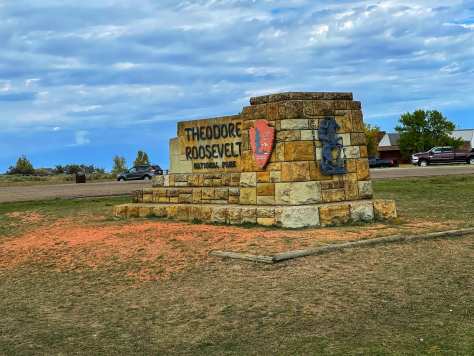




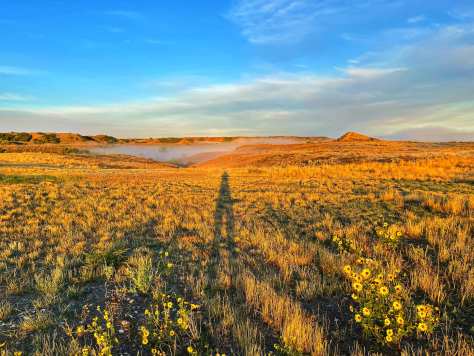
I slept soundly, in fact too soundly. I woke blurry, dull, and two hours later than my usual wake time. I made some coffee, but I didn’t feel hungry. I decided to wait until I could find a drive-through where I could grab a quick breakfast sandwich. After washing my face and brushing my teeth I pulled myself into Violet’s driver seat and headed west down I-90 towards Bozeman. My GPS signaled that I was three and a half hours away.

Meetup-Day One
I drove down Stimson Lane and caught sight of a row of Ram Promasters in a field on my left. A colorful “W” followed by the words, “Wayfarer Vans” highlighted the entrance to the venue. I pulled in and was greeted by a cheerful staff member who handed me an envelope full of stickers and an itinerary. Another staff person acted like an airport marshaller and slotted Violet between two other vans. Once given the signal I placed her in park, turned off the key, and exited her confines.
Ten of the forty or so vans had already arrived. Most people were sporting large 136 or 159 wheelbase Promasters, but some were driving the much smaller Promaster City. Wayfarer Vans had custom packages to convert all flavors of Promaster. There was a size for every taste.


To the left of me was a Promaster 159. It was occupied by two ladies from Nevada, Joyce and Ellen. They were both long-divorced who raised their respective children as single parents. They were also long-time friends who eventually decided to live together. One of them was in her 80s and they gained my respect with the knowledge that they had mutually bought the Promaster just last year so they could continue to explore the country. They were instantly warm and welcoming.
On the other side of me was a man in a Promaster City. Alan had a slight but wiry build that announced that he was a life-long athlete. He was gregarious in an effortless way, and he instantly engaged me in conversation. After some time he moved to another group and acted similarly. I could hear him laugh and joke with total strangers as if he had known them for years. I was envious of his ability and felt a bit ashamed that I was lacking in that area.
Across me was a man who identified himself as a confirmed bachelor. Doug had moved from big LA to small St. George, Utah. He said moved because he didn’t like what was happening in California. I felt that it was best to not press for more information, but I made a mental note to keep my liberal leanings to myself. Doug was a professional voice-over actor who could ply his trade anywhere that he had an internet connection. He was a friendly guy who was enjoyable to talk with.
Down the lane was another single man who had two immaculately groomed Schnauzers, a male, and a female wearing respective blue and pink harnesses. Vern was a retired IT professional who lived in LA and had a love of gadgets and a problem-solving mind that reminded me of myself. We got to talking and he revealed that he grew up in Chicago in the same neighborhood as I did. However, he lived on the east side of Western Avenue, while I lived on the west side. Another man entered our conversation and when he found out that we grew up in the same neighborhood he commented that we were probably playmates “in the day.” Vern and I shot each other a glance as we both chucked and said, “probably not.” Vern was black and I was white. Chicago was a racist town in the 1970s. How grateful I was that this was 2021 and not 1971. I think Vern and I could have been good friends in the day if not hampered by the limitation of our upbringing.
I was making a strong and good effort to socialize, but I was doing so by putting on my functional extrovert persona. It was fun, but also exhausting. I retreated to Violet for a supper of another roast beef sandwich, made expressly to use up my open package of cold cuts. The remaining event for the day was a bonfire, and despite my exhaustion, I was committed to going. The bonfire was actually a lava rock filled circle outfitted with a number of Bunsen burner like jets. It was an odd device likely designed to safely burn in arid and fire-prone Montana. I spotted a familiar face next to an open seat and approached the person asking if the adjacent spot was taken. “I think so,” was the reply. I quickly moved to another spot and sat quietly as my level of awkwardness built. I fumbled with my phone and tried to look occupied, but within short order, I knew that I wanted to leave. I had pushed my envelope about as far as I could and there was nothing left in me that would allow me to once again start a conversation with a new stranger. I was spent. I planed an exit strategy that I thought would be subtle. I would go to the Port-a-Potty and then sneak off to Violet. This was exactly what I did. Once inside I pushed in my Relfectix shade, popped in my Apple AirPods, and clicked on the audiobook that I was listening to, Becoming by Michelle Obama. I sat in the quiet with Violet’s cabin illuminated by 4 battery-operated faux candles that changed colors in a rhythmic and calming pattern. The instant relief that I felt verified that I had made the right choice. I’m an introvert and I can only do so much socializing. Yet, despite all of my good efforts, I feared that I had failed. I was judging myself based on a passing grade of being 100% perfect.
I wondered if I had made the right choice by coming to the meet-up. I was playing my comparison game. Everyone seemed to have an easier time socially connecting. I had done well enough, but I was play-acting. I felt inadequate and slightly ashamed. Yet, Violet’s safe and secure surroundings gave me the courage to go for day two.


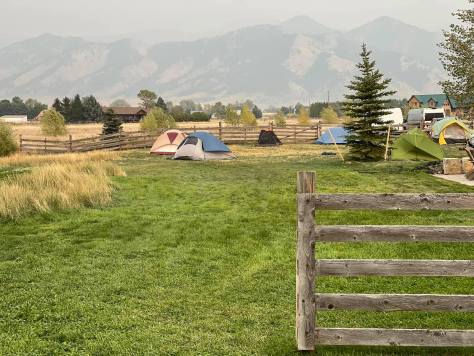
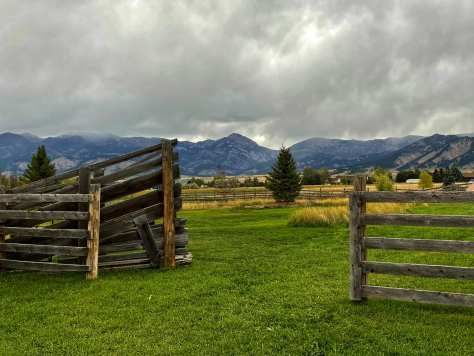
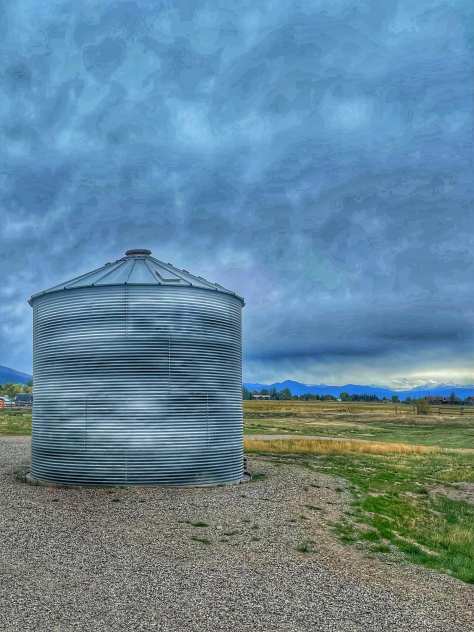
Meetup-Day Two
I woke up and ripped open a pudgy package of Epic XL shower wipes. These one-by-two foot wipes have a slight eucalyptus fragrance and can serve as an emergency shower. Since showers were not available at the ranch the Epic wipe would have to be an acceptable substitute. As a dry camper, I am experienced using the wipes knowing that you start by cleaning your cleanest parts as you progressively scrub ever more needed regions. Once hygienic I brushed my teeth, sprayed on a little cologne, and dressed.
I exited Violet and immediately went over to the two ladies’ van as they were holding court with several other van dwellers. They welcomed me and I felt at ease entering their circle. The members of the group were no longer strangers, they were now, at least, acquaintances. We all meandered to the barn for breakfast but we were greeted by a sign saying that it was delayed due to a catering mess up. Our conversation continued in the barn and I revealed to them for the first time that I was a physician. Perhaps oddly, I don’t like to tell people that I’m a doctor as it can sometimes set up an artificial barrier.
Eventually, food arrived, an enormous selection that was quickly gathered from local stores by the Wayfarer staff. We listened to a few talks after breakfast, and then the group broke up to go to various scheduled activities-mountain biking, a short hike, or free time. I thought about going on the scheduled hike, around two miles, and regarded as moderate. I knew that this level of exercise was within my capabilities, but I held back. I didn’t want to slow up more athletic hikers. This was another old tape from the past. I never played team sports because I didn’t want to pull others down with my insufficiencies. Always being told how uncoordinated I was I believed that I would be a harm rather than a help to any team that I would join. I didn’t feel that I needed to challenge myself with this. I elected to take my iPad back into the barn, now empty and quiet, and to start this post. It was the right decision to make.



Eventually, I tired of writing and wandered back towards the campers and engaged in a number of conversations. The staff videographer asked me if I wanted to do a video tour of Violet. I agreed and the interview began. After the interview, we talked about cameras, editing software, and wireless microphone choices. Other van dwellers then came up to me with questions about Violet’s solar panels, microwave oven, organizational boxes, and Wabasto heater.

Jinny was a newbie who had questions about my induction cooktop. She was a bit unusual as she was an older Asian woman traveling solo. I made an honest effort to encapsulate useful information about induction cooking and how I monitored my electrical system to make sure that had enough power for my other devices, such as my Dometic fridge.
Later Jinny showed me her van, a completely tricked-out Promaster 159. I got to know her a little better and it was clear that she had given a lot of thought to adopting this new lifestyle. She had the book knowledge and it seemed like she was now hoping to gain the practical knowledge to successfully travel in a van.

As in my conversations with other van dwellers, I didn’t want to assault her with my professional interviewing style. The style where I can learn everything from a person’s favorite color to details about their sex lives in 45 minutes or less. What I would learn about Jinny would be what she would choose to tell me.
She told me that she had a huge house in Seattle that she recently sold. She purchased several acres of land outside of Seattle that already contained a 3 car garage and an RV garage. She bought the land because of the RV garage and bought an RV without ever driving one. This was a mistake as the lumbering behemoth was stressful to drive. She sold the RV and was much happier with her Wayfarer van.
She had a shed built on the land and had it converted into a tiny house. The residence didn’t have a kitchen but was reasonably close to the company that she owned. When her employees went home in the evening she use her workplace kitchen to make Hello Fresh types meals, a portion which she brought back to her tiny house. This seemed to work for her. Jinny was in the process of building a fourplex on the property, which she would rent out. Once completed she would retire and use the rentals for her income.
Jinny showed me a photo of her beautiful daughter and her adorable grandchild. They were living in Minnesota and I believe she was establishing her nomad lifestyle so she could spend more time with them. I thought to myself, “What a fascinating person.”
Then it was time for another catered dinner. This one consisted of a make-your-own taco bar but added the twist of pull pork and chicken mole fillings. Here I found Bill. I had talked to Bill a few times before. He was sitting alone and I asked him if I could join him. Bill was a tallish man with a wild horseshoe style mustache. Bill retired from the airlines after working for them for over 40 years. He then converted his passion for woodcarving into a successful mail-order business but shuttered its doors when the company became so successful that it sucked the joy out of his hobby. Bill said that he was always fascinated with trucks, so he then got his commercial license and became an 18 wheel truck driver for 10 years before he finally retired.
Bill lost his wife 3 years prior to our meeting and it was clear that he still missed her terribly. A former Chicagoan, he had moved to Mesa, Arizona decades earlier where he raised his two sons. Bill was immensely proud of his two boys, one who lived in Colorado and the other in Arizona. They came up in every conversation that I had with Bill. I liked this about him. Bill became my dining partner for the rest of the event. I could imagine him as a next-door neighbor and friend who would stop by for coffee and chat. That would be fun.
There were so many others that I talked to. The couple originally from Glen Ellen, Illinois now living in Steamboat, Colorado after raising their kids. They seemed the executive type, pleasant with ease with strangers that comes from years of neighborhood gatherings and business meetings. They commented on how neat and organized Violet was. I had to chuckle because they were right. Three years of my obsessiveness combined with friend Tom’s carpentry skills had turned Violet into a well-oiled machine where there was a place for everything and everything had its place.
There was Dana, a single woman in a 159 Promaster who was also fairly new to van travel. She had purchased some folding solar panels, but she was afraid to use them. I helped her set them up as I tried to emphasize how easy the process was. Dana was very social on day one but then seemed to disappear. She left early noting that she wanted to beat the bad weather on her journey back to Colorado. I felt that she had had enough of this adventure and wanted to return to the security of her basecamp.
There was a couple from Indianapolis. I met the first one during breakfast on day two and then her wife on day three. They owned a coffee shop in Indie but were hoping to sell it so they could explore America in their camper van.
There was the couple where the woman slept in her tiny converted Promaster City and the man slept in an adjoining orange tent. I’m not sure what their status was. Couple? Friends? Whatever their status it was clear that they genuinely liked each other.
There was the guy with the giant German Shepard and the lady with the Golden Doodle and so many more. When I saw someone I didn’t know I went up to them, introduced myself, and started a conversation.
The day ended back in Violet’s welcoming chamber, AirPods in, audiobook on.
Meetup-Day Three
I woke up to frigid temperatures and instantly turned on the Wabasto. Like the day before I procedurally went through my hygiene and dressing ritual and then went outside to socialize. Soon it was time for breakfast, sort of a Continental affair. I grabbed a fruit cup, muffin, and a small parfait and balanced a cup of coffee on top of my plate as I made my way from the food line up the stairs to the dining tables. I sat with a group of familiar faces as I sipped my coffee and nibbled on my muffin. I smiled and occasionally offered comments as they talked about everything from the cold weather to Elon Musk.
The frigid weather forced a number of van dwellers to pack up and leave as another number of them went off on various explorations. I hunkered down in Violet, as the only jacket that I packed was a light hoody. On occasion, I would wander out to re-engage with other dwellers to have pleasant conversations as I continued to reinforce my socialization skills. However, after doing this for the two previous days I was also happy to have my alone time. I wrote, read, and talked on the phone. Prior to my journey, I had planned on taking a side trip back to Yellowstone, as it was only 90 minutes away from Bozeman. However, my weather app said that the high in Yellowstone was going to be 42F on Monday, with a low of only 16F. Some snow was also predicted. I mentioned my change of plans while on the phone to my friend Tom, who was insistent that I should go anyway. That was Tom, who was always interested in exploring and learning something new. However, my short pants and thin hoodie suggested otherwise. I told Tom, “We’ll see,” code to let him know that I wasn’t going to do it and that I didn’t want to debate my decision. He understood, and we changed the subject.
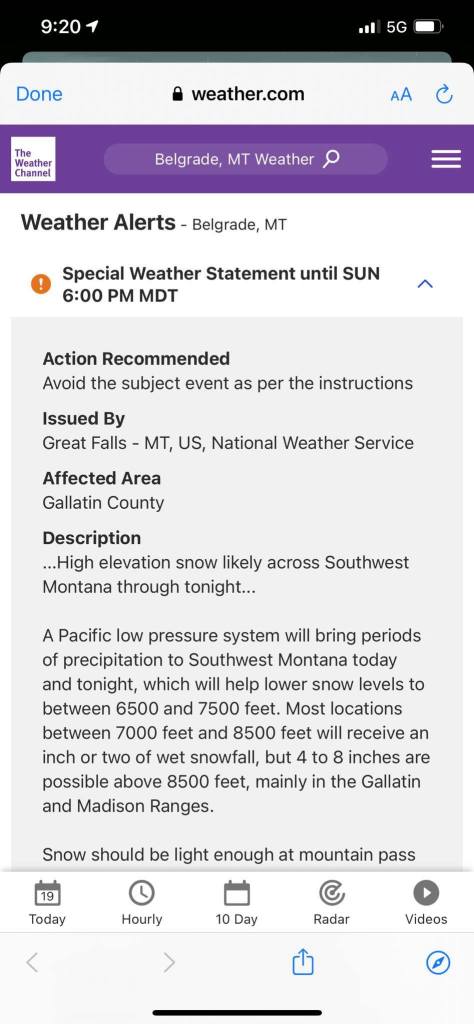
I had now found my pace at the meetup. Mixing socialization times with alone times gave me the balance that my introverted self required. More conversations followed with Vern, Jinny, the camera guy, and others mixed with writing, reading, and thinking. I was no longer exhausted, no longer mad at myself for not being the best “socializer” in the group. I no longer criticize myself for not challenging myself further. I was content.
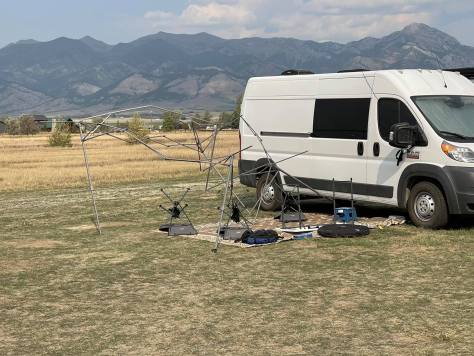
Meetup-Last morning and the road.
Half of the 40 vans had already left the event. I heard some people outside chatting, but many chose to avoid the bitter cold by staying inside their vehicles. Eventually, it was time for breakfast. This last meal was dubbed a “Grab and Go” meal. However, most of us grabbed and sat down. I found Bill and we both went down to the buffet line. Balancing a biodegradable style plate I examined and placed items into it. Some sort of egg dish, a small muffin, a little fruit. At the end of the line was the coffee. The cups were small, and so I filled two of them. Now I had to figure out how to balance two cups and a floppy plate up the stairs to the dining hall. I didn’t do this gracefully, but I manage to get to the table without dropping everything.
We sat and chatted and Bill invited me back to his van as I had expressed interest in how he liked a partition that he had purchased that isolated his van’s cabin from the front cab. At the end of the demonstration, he offered me a few pre-soaped sheets that he said were great at removing van bug reside. In my mind it was a gesture gift, suggesting a new friendship.
I said a few more goodbyes, to Doug, the coffee ladies, even some random folks who I had never talked to. I went back to Violet and made sure that her cabin was secure, lest everything wouldn’t go flying when I hit the road.
I wasn’t going to go to Yellowstone, but I wasn’t finished with exploring. I set my GPS for downtown Bozeman and drove out of the ranch. Bozeman is a town of around forty thousand and its downtown looks very similar to my hometown of Naperville. Two and three-story buildings, many appeared that they were constructed during the first half of the last century. They were well maintained and the shops that they contained suggested that the town was doing well. Sporting goods, coffee, bikes, spices and teas, the list went on. I took a few photos, but I was chilled and didn’t linger.



I like visiting colleges and so my next stop was Montana State University, which was about six minutes away from downtown. Here too, I got out and wandered. The campus was spotless and pretty. However, it was sized more like the small North Central College in my hometown rather than the behemoth state universities that I’m accustomed to in Illinois. Yet, it is the largest university in the state of Montana, with an enrollment of around fourteen thousand students. I milled around with the students as they marched to their next classes and I was struck by how similar they looked to students that I had witnessed at other colleges that I had visited. Some were wearing heavy down vests, others in t-shirts and shorts. Some with expensive clothes, others wearing Goodwill bargains. Each bright face a potential future Elon Musk or Warren Buffett. I looked at the grey hairs on my arms and then back to their eager faces and I became acutely aware of the different phases of our lives. They were speeding towards expectation, I was lumbering towards acceptance. We were both still moving, still growing. However, I no longer felt the anxiety of urgency. Rather, I was taking what I had and tweaking it to better fit who I wanted to be.


I returned to the comfort of Violet and searched for a gas station, which I found on the edge of Bozeman’s downtown. A tiny station with a small convenience type store. I put the pump on automatic and went inside to grab a cup of coffee. After filling a 16 oz styrofoam cup I wandered the store looking for a perfect snack. There were rows of candy bars and protein bars. Aisles of popcorn and beef jerky, end caps of snack cakes. I took it all in, but nothing really appealed to me. I approached the front counter and was greeted by a woman in her 40s. She said, “Is that all?” I could tell that she was sizing me up, and I must have looked a sight. In front of her was an old man, somewhat disheveled, and with a full week’s growth of beard. I saw her glance at me and then at Violet. I could only assume that she thought I was homeless and I was concerned that she was passing judgment on me. She repeated, “Is that it?” “Yep,” I said and reached for my wallet. She said, “It’s only 99 cents and guess what?” I replied, “What?” She looked at me and gave me a big smile, “It’s on me.” My eyes misted up and I returned the smile, “Really? Thank you!” This lady was likely making minimum wage yet she was reaching out with kindness to a stranger who she had never met and who she assumed needed a little TLC. I felt lifted up by her random act of kindness.
The next days would be grueling as I wanted to return back home in two days, rather than the three that I allotted. Once again, I entertained myself with old radio shows, NPR, audiobooks, phone calls, local radio stations, and thinking. As I drove the miles I would cycle through these options. As soon as one would become tiresome I would move to another.
I came across a National Monument, Pompey’s Pillar, a rock formation in central Montana. The site is famous for many petroglyphs as well as the carved signature of William Clark of Lewis and Clark fame. Apparently, his signature is the only remaining physical evidence of his journey with Meriwether Lewis. It felt good to gain free entry using my lifelong National Parks Senior Pass. The ranger at the gate gave me a full history of the site and urged me to watch the park’s movie and to talk to the other rangers who were stationed on the rock itself. Another nice person!


There is only so much time that you can spend climbing a 200-foot rock, and it wasn’t long before I was once again sitting in Violet’s driver’s seat, heading east. Driving in the western states of Montana and North Dakota is a lesson in isolation. A thin ribbon of asphalt propels you forward, but much of the landscape remains the same. Brownish green brush, endless rocks, the occasional buff or range of mountains. It is all extremely beautiful, but disconcerting for an urban lad, such as myself. I’m used to a certain degree of noise and congestion and I gain a level of comfort knowing that there are 5 gas stations, 3 grocery stores, and two hardware stores writhing a 5-minute drive from my house. On I-90 I could drive 50 or even 100 miles without seeing a human-made structure. I passed countless exits with signs that stated “No Services.” With no connected town, these exits seemed to drop off the end of the earth into a zone of nothingness.

As I drove I sipped coffee, then Diet Pepsi, then water. I rutted through my snack bag and munched on various trashy treats-Chex Mix, pretzels, Belvita bars. The amount of non-nutritious foods that I was eating made me feel sick, and I longed for a salad. However, that longing didn’t stop me from once again reaching into the bag to grab another crumb.
It was now around 6 PM and both Violet and I needed to fill up. Google told me that there was a gas station 26 miles ahead, the only one-and so that would be my stop. At the station, there was a man with snow-white hair and a bushy mustache who was fueling his Tahoe. He was pulling a fishing boat and heading west to Washington state. He too was a solo traveler and clearly feeling lonely. In short order, he started to tell me his story, but I had to cut him short as I wanted to grab dinner from the Cenex store. I entered the establishment and was greeted by the intoxicating aroma of gas station pizza. However, when I wandered back to the food zone I was disappointed to only find three items on the warming shelf. Two boxes of chicken strips and a breakfast burrito. It appeared that they had been heated hours before and I couldn’t bear the thought of eating them. I grabbed a bag of popcorn and a bottle of diet Mountain Dew-that would be my dinner for the evening.
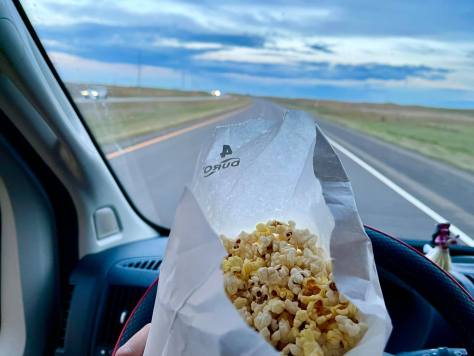
Yes, dear reader, I had a fridge and pantry full of things that I could have made. Eggs, canned soup, lunch meat, and even some vegetables. However, I just wanted to keep going. I was missing my loved ones and wanted to get home.
I drove on until I could drive no further. However, there was nowhere to stop. No town, no hotel, no truck stop, nothing. Now deep into North Dakota, I spied the blue and white sign of a rest stop. At last! My plan was to camp out there until the morning, but my heart sank when I drove in and saw a large black and white sign that said, “No Overnight Camping.” I knew that it was best practice to move on, but I had nowhere to go. I pulled into a slot and search for information on North Dakota’s DMV site. They stated that it was illegal to park longer than three hours at their rest stops and that they considered that sleeping in a van was camping. It couldn’t be any clearer. Despite being exhausted I assessed my situation and came up with a plan. Sleeping 3 hours would allow me to drive further to some other place, perhaps another rest stop or a truck stop. There I could repeat the practice. I set an alarm for three hours and crawled into Violet’s bunk. This time I didn’t change into my sleeping shorts. I wanted to be ready to move if an officer banged on my door and forced me to drive on. Apparently, I turned off the alarm during the night because I woke at 6 AM-rested. No one bothered me. I meandered to the bathroom, which was completely empty. I took a photo in there-a perfectly OK thing to do considering that I was alone, but somehow it felt a bit wrong. Then I was on the road again.
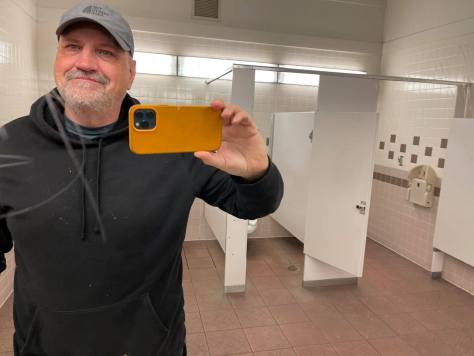


My last travel day was similar to the one before it. However, as I went further east both the landscape and the population changed. I drove on listening, thinking, snacking. Julie was texting me and pressing me about my location and when I planned on returning to Naperville. I was being deliberately vague as I wanted to surprise her by showing up a day early. Dear reader, I’m not very good at deception, but I did my best. She called me when I was driving through Aurora, about 15 minutes from home. I tried to divert her direct questions and I could clearly hear the frustration in her voice. When I arrived she was happy to see me but also peeved at me. Later, Kathryn told me that Julie was worried about me because I was acting uncharacteristically confused. She thought I could get lost or fall asleep on the road and she was concerned. Apparently, her being miffed with me was based on this unnecessary worry. I apologized.
I finish this post from the comfort of my little study with its mullioned windows and overstuffed leather easy chair. Despite its small size, it is larger than Violet’s living space by a magnitude. My environment is now a controlled 72F and I have a bathroom only a few paces away. Last night I took an endless shower, rubbing a thick bar of creamy soap over my body. I shaved away a week’s worth of beard and felt the spacious wonderment of a king-size bed, silky sheets, and puffy pillows.
I’m glad to be home, but I never felt deprived living out of Violet. I planned her environment well and that planning has served me.
My out-or-proportion anger towards Tom surprised and shocked me. The stress of the trip combined with the play and a few poorly chosen comments took calm and collected me and transformed me into a person that I felt that I had long left behind. Yet, it was still there. Issues from the past still haunted me 50 years later. It was a humbling experience.
I have taken long trips solo in the past, but that doesn’t mean that they are not stressful. I can fill hours of time alone, but it is more enjoyable to ride with a co-pilot. Whether that is Julie or William sitting next to me, or Tom driving his own car.
My biggest challenge was interacting with 75 strangers in a confined setting. Lessons from the past taught me that I should be seen but not heard and it has always been enormously difficult for me to initiate a conversation with a stranger. Over the years I have observed how my friend Tom easily connects with others and I have modeled those observations to successfully break my inhibitions. However, this would only involve a single person and for a short period of time. I have never challenged myself to do so with 75 strangers in a venue that ran for days.
I was down on myself on day one. Yes, I had started up multiple conversations with numerous people. However, I was judging myself against another and clearly coming up short. His incredible ease of socializing made my efforts look paltry. By the time that I was rejected at the bonfire, I was already exhausted and spent. This amplified my feelings of inadequacy and I wondered why in the world did introverted me subject myself to this extroverted challenge. I return back to Violet feeling defeated and exposed. Inside I felt a rush of relief and comfort. During that moment I gained a better understanding of myself. I am an introvert, I could expand my abilities and develop my social skills, but I would always be an introvert. Extroverts, like Alan, are different creatures who gain energy from their interactions. I enjoy people, but I need to recharge away from them which is why isolating in Violet felt so good.
Indeed, I had made great progress. Years ago I would have never approached a stranger to start a conversation. Lately, I have had no problem doing this. Now, I was on a trip that would force me to drive 3000 miles alone for the purpose of interacting with 75 strangers over an extended weekend. I wasn’t Alan, but I was still doing pretty well.
As soon as I recognized what was going on I altered my approach. I would still socialize. I would still initiate. However, I would give myself times to recharge in between. Sometimes I would quietly think, or read, or write. Any of these behaviors were enough to top off my battery and allow me to move forward and experience more.
The people that I met were all different, but they had a common thread-they were all incredibly nice and very interesting. How fortunate I was to interact with them. The hosting crew was also beyond pleasant. I got to chat with Ian, the owner of Wayfarer Vans for a bit. I asked, “Why didn’t you bring accessories to sell?” He replied, “I wanted this to be a family event, not a commercial one,” He succeeded.
I learned a little more about van life and a lot more about many interesting people. Beyond the weekend warriors, there was the lady who bought me a 99 cent cup of coffee, the ranger who wanted to share the excitement of Pompeys Piller, and the man with the bushy mustache who just wanted to talk to someone. Each was kind, accepting, and generous in their own ways.
At 68 I still have much to learn. Without realizing it I still am battling with demons from my past. However, I continue to grow and advance. I am who I am and some things will always be out of my reach. With that said, I’m not a static creature locked into a persona created decades earlier. I’m evolving in all ways. My goal is to continue to grow but to also accept myself. As an adult, I feel that I had pretty good ego strength. However, it only took a few events to make me return to a past time. I wasn’t able to shake off a minor blow to my self-respect. I turned a molehill into a mountain. Thankfully, with the help of others I was able to understand that process and (hopefully) use it to be a better person in the future.
I am so grateful to be me. Living in my little town, touring in my little camper. I will never be the most popular kid on the block, or the most famous, or the richest, or the most accomplished. However, I feel that I am loved and I love others. What more could I ask for?
Peace
Mike
